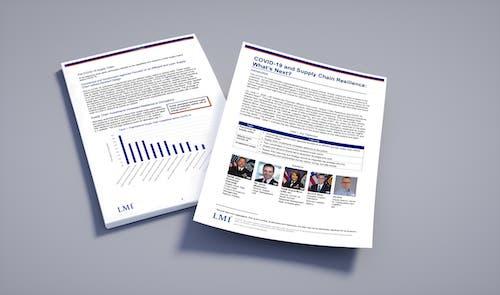
COVID-19: What Suppliers Can Do Now
Kerry McCarthy Pandemic Response Support, Supply Chain Resilience, Innovation at the Pace of Need™, Disaster Preparedness, Risk ManagementThe COVID-19 pandemic has reminded us of the first rule of supply chain resilience: do not put all your eggs in one basket. The vulnerability of supply chains with geographically concentrated raw materials or production has strained the availability of highly sought healthcare items like facemasks and pharmaceuticals, the global supplies of which largely depend on China. While countries with organic manufacturing capacity may buttress supplies to help meet spiking internal demand, a great many countries have no recourse. The dearth of diversification in manufacturing locations and operators exacerbates an already stressed global system.
This predicament is hardly surprising. In 2011, the LMI Research Institute (LRI) assembled experts in economics, supply chain, and government service to review the lessons learned from the H1N1 virus outbreak in 2009 and recommend improvements to pandemic preparedness and response. The LRI report noted a pandemic would introduce profound second- and third-order effects on supply chains beyond the medical emergency itself; nearly all federal and state plans failed to account for these effects and seldom even acknowledged them. The long-term effects of COVID‑19 may be even greater than we anticipated as the supplier base for some items, especially pharmaceuticals, has further consolidated over the past nine years.
While suppliers have tough choices in front of them, there are steps they can take now to navigate this dynamic environment and position themselves to better manage the risks sure to emerge in the weeks ahead. As President Eisenhower said, “Plans are useless, but planning is indispensable.” Supply chain professionals across all industries should remember these steps as the pandemic’s ripple effect grows.
Understand future requirements and prepare to improvise.
How will demand for your production change in the short and long terms? Learn what you can from outcomes in other countries to identify and focus resources on critical dependencies. In some cases, it may take creative problem-solving to adapt resources. Manufacturing lines can be repurposed, as we have seen with LVMH shifting perfume production to hand sanitizer. Animal ventilators could be modified for COVID-19 patients to help healthcare facilities provide lifesaving treatment. With the prospect of the federal government invoking the Defense Production Act to increase availability of critical resources such as ventilators, organizations should be thinking about how to improvise nontraditional solutions from existing resources.
Maintain dialogue with suppliers to reduce uncertainty.
Engage suppliers as far down in your supply chain as possible, even to the raw material level, which is often overseas. Knowledge of when and how your suppliers may be affected—anything from limited material availability to factory closures to longer lead times—will expedite risk identification and help forecast when your operations may be disrupted. Whatever information you gather will make your planning and risk management more effective.
Capture lessons learned now and prepare to invest accordingly.
Knowledge management is critical to planning. Continue capturing lessons as you go via planning documents, actions, and costs (including time and resources) to understand your total investment in the response. When normal business operations resume, perform a comprehensive assessment while the lessons are fresh and use that knowledge to invest strategically. Given the extraordinary disruptions experienced thus far, investment that strengthens resiliency in difficult times will be a bargain at any price long term.
What is the Defense Production Act?
On Wednesday, March 18, President Trump invoked the Defense Production Act (DPA) in response to the COVID-19 outbreak. The act “provides the President with an array of authorities to shape national defense preparedness programs and … maintain and enhance the domestic industrial base.” Specifically, the DPA allows the U.S. government to take steps in dealing with a national crisis such as COVID-19, including the promotion of industrial resource preparedness and response to reduced supplies of strategic and critical materials. For example, the government can ask U.S. companies to repurpose production lines from commercial to healthcare items (e.g., gloves, protective clothing for healthcare workers) or increase production of items such as ventilators. The first step in using the DPA is the President’s invocation; the next steps will play out in the coming days and weeks with regard to where the U.S. government allocates resources.
-
 Solutions
SolutionsSupply Chain Resiliency
LogSmart™ Supply gets you the on-demand insights you need when you need them, so you can secure actionable insights on top of your existing supply chain illumination data, increase mission performance, and more.
Download Use Case


Kerry McCarthy
Practice Area Lead 2, Supply Chain ResilienceKerry has worked with the Department of Defense, Department of Agriculture, NASA, Amtrak, FEMA, and NATO to improve their supply chains resiliency.

Resources To Navigate the Age of COVID-19
Visit our resource center for the latest information and insights to help our federal clients navigate the age of COVID-19.


